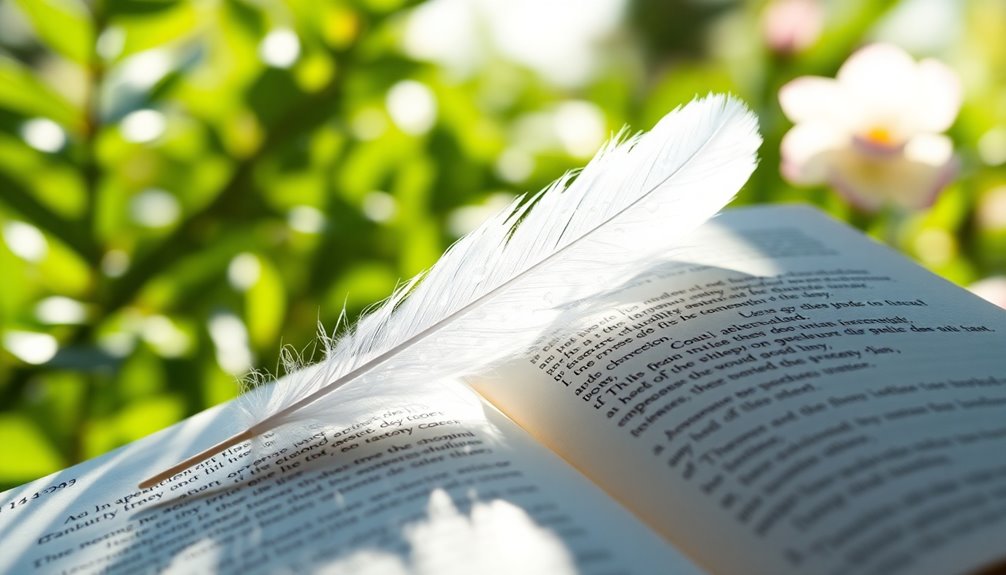Symbolism in poetry is all about discovering hidden meanings that connect everyday images to big ideas. It's like finding secrets within the words! For instance, a rose can symbolize love, while a key represents freedom. By recognizing these symbols, you reveal deeper emotions and themes. Poetry often uses colors and nature elements to evoke feelings and convey messages. When you spot repeated images or unique word choices, you're on the right track. This can lead to exciting interpretations and critical thinking! Keep exploring, and you'll uncover even more fascinating ways poets use symbolism to enrich their work.
Key Takeaways
- Symbolism in poetry involves using objects, images, or actions to represent larger ideas and themes.
- Common symbols include roses for love, doves for peace, and keys for freedom.
- The interpretation of symbols is influenced by cultural contexts and personal associations.
- Effective symbolism enhances emotional depth and invites multiple interpretations from readers.
- Poets often use symbolism to comment on social issues and inequalities, enriching the poem's meaning.
Definition of Symbolism
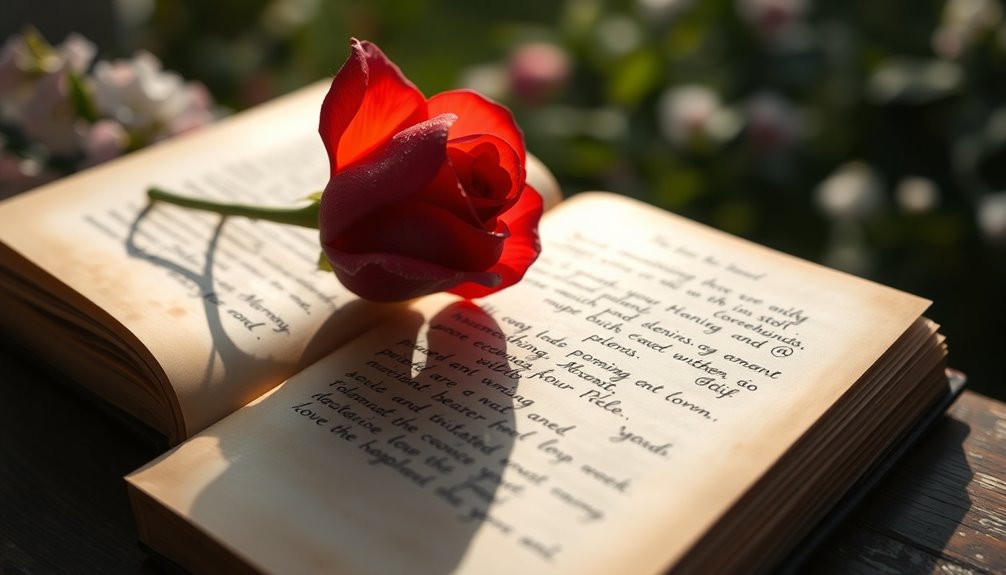
Symbolism in poetry is like a key that reveals deeper meanings within a poem. When you read a poem, you might notice certain objects, images, or actions that stand for bigger ideas. That's symbolism! It's a clever literary device that helps poets express complex feelings and themes in a way that's easy to understand. For example, a rose might symbolize love, while the color black could represent death or mystery.
These symbols can touch your heart and make you think. What's exciting is that the same symbol can mean different things to different people, depending on their backgrounds and experiences. That's why context matters so much!
When you immerse yourself in a poem, try to uncover the symbols and see what they mean to you. Understanding symbolism in poetry can reveal hidden themes and emotional layers. It allows you to engage with the poem on a deeper level, connecting your feelings to the poet's message.
Importance of Symbolism in Poetry
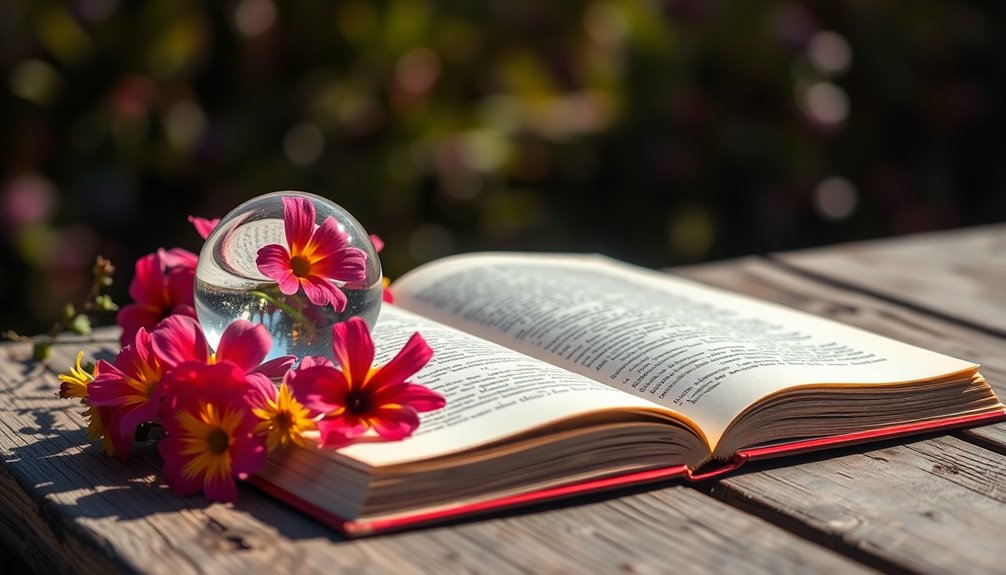
Symbolism in poetry is super important because it adds emotional depth to the words you read.
It helps you connect with themes and ideas in a way that feels personal and meaningful.
When poets use symbols, they invite you to engage and explore, making the experience of reading poetry even more exciting!
Emotional Depth Enhancement
When you immerse yourself in poetry, you'll often find that the use of symbols enriches the emotional landscape, allowing you to connect personal experiences with the poem's themes.
Symbols can turn abstract feelings into something tangible, creating a deeper connection between you and the poem.
Here's why symbolism matters for emotional depth:
- Evokes Strong Feelings: Symbols help you relate your own experiences to the emotions in the poem. A simple image can spark a powerful memory or feeling.
- Conveys Complex Emotions: Poets use symbols to express intricate feelings without lengthy explanations. A single symbol can say so much!
- Encourages Personal Interpretation: Each symbol invites you to explore your own feelings and ideas, making the poem more personal and relatable.
Theme Reinforcement
Poetry thrives on the power of imagery, and symbols play an essential role in reinforcing its themes. When you read a poem, you might notice how symbols turn abstract ideas into concrete images. This makes the themes much clearer and more relatable. For example, a poet might use the color red to symbolize passion or danger. This color can evoke strong feelings, supporting the theme of the poem.
Nature also serves as a powerful symbol. Think about how flowers can represent love, or how falling leaves might symbolize loss. These symbols connect personal experiences to universal truths, helping you understand the themes on a deeper level.
Reader Engagement
Imagery in poetry often invites you to engage on multiple levels, and symbols are key to revealing deeper meanings. When you use symbolism, you're not just reading words; you're immersing yourself in a world of emotions and ideas.
Here's why it's so important for reader engagement:
- Multiple Interpretations: Symbols let you explore different meanings. Each reader might see something unique, which makes every reading special.
- Emotional Connections: Symbols create links between your own experiences and the themes in the poem. This connection can make the feelings even more intense!
- Critical Thinking: Engaging with symbolism encourages you to think deeply. You'll analyze the context and significance, which helps you appreciate the poem's themes even more.
As you uncover these layers, you'll notice that symbols can turn ordinary moments into powerful reflections. They make poetry not just words on a page, but an exciting journey.
When you embrace symbolism, you enhance your reader engagement, transforming how you feel about the poem. So, immerse yourself and discover the joy of symbols—they're waiting to connect with you!
Recognizing Symbolism in Texts
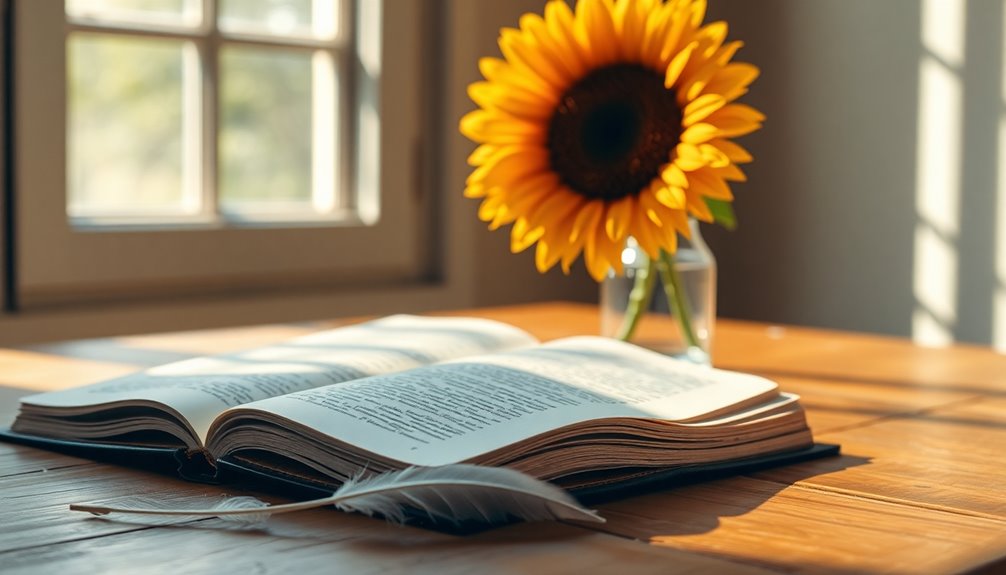
Delving into the layers of a text can reveal rich symbolism that enhances your understanding of its deeper meanings. When you read poetry, pay attention to repeated images or motifs. Symbolism is often hidden in these details, suggesting ideas beyond the literal words. Many poets utilize utilitarian principles to convey moral messages through their symbolic language.
To help you recognize symbolism in texts, here's a handy table:
| Technique | What to Look For | Why It Matters |
|---|---|---|
| Striking Imagery | Bright colors, strong visuals | Creates emotional responses |
| Unique Word Choices | Uncommon or specific vocabulary | Adds depth to the poem's meaning |
| Context of Symbols | Where and how symbols appear | Reveals the poem's emotional tone |
| Personal Associations | Your own experiences with symbols | Makes interpretation unique and personal |
Analyzing the context can reveal the emotional tone and thematic significance. Remember, individual interpretations can vary, and that's okay! Your unique insights add value to the reading experience. Understanding the cultural or historical significance of symbols can also enhance your appreciation of the text. Additionally, engaging with art theory can deepen your exploration of symbolism by providing a framework to analyze the artistic choices within the poem. So, immerse yourself and explore the layers waiting for you!
Types of Symbolism
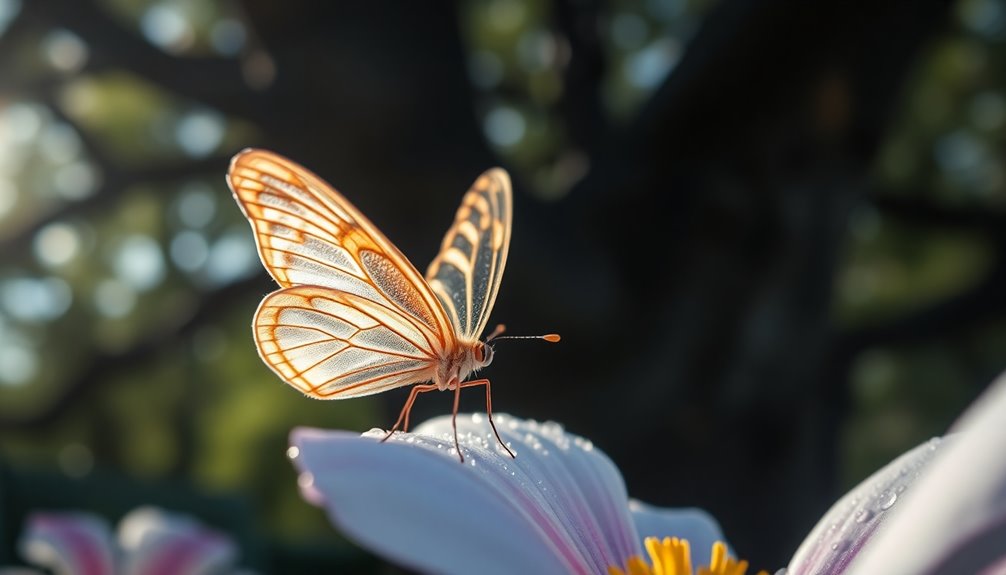
When exploring the world of symbolism, you'll find various types that can deepen your understanding of a poem's message. Each type of symbolism adds a layer of meaning, making the poem more exciting to read.
Here are three major types to evaluate:
- Color Symbolism: Colors can evoke strong feelings. For example, red might symbolize love or anger, while blue often represents calmness or sadness.
- Nature Symbolism: Nature is full of symbols! A rose can stand for love, and spring can symbolize renewal and new beginnings. These symbols connect us to the world around us.
- Object Symbolism: Everyday objects can hold deeper meanings. A key might symbolize access and freedom, while chains can represent imprisonment. These symbols reflect our human experiences and societal issues.
Understanding these types of symbolism helps you appreciate how poets use figurative language to convey their thoughts and emotions.
Examples of Symbolism in Poetry

Now, let's explore some exciting examples of symbolism in poetry!
Poets like Wordsworth and Dickinson use symbols from nature to share deep feelings, showing how a simple flower or light can represent joy and hope.
You'll see how these symbols connect us to emotions and ideas, making the world of poetry even more magical!
Notable Poets' Symbols
Symbolism in poetry brings deeper meaning to the words, allowing readers to connect with emotions and themes on a profound level. Notable poets often use symbols to express complex ideas.
For instance, in William Wordsworth's poem, the rainbow serves as a symbol of love, capturing the joy and beauty found in nature. It reminds us of the wonder of childhood and the hope that colors our lives.
Here are some more symbols from famous poets:
- Percy Bysshe Shelley: The moon symbolizes loneliness and unrequited love. It evokes feelings of longing and despair, making you reflect on your own experiences.
- A. E. Housman: The ferry represents death and the inevitability of fate, reminding us how transient life can be.
- Emily Dickinson: Light symbolizes hope and happiness in spring, showing us renewal and the promise of brighter days ahead.
These symbols make poetry rich and meaningful. They invite you to explore your own emotions and experiences, creating connections that last long after you've put the poem down.
Nature's Emotional Impact
Nature has an incredible ability to mirror human emotions, making it a powerful tool for poets seeking to convey complex feelings. When you read poetry, you'll often discover how symbolism in nature enhances the emotional impact of the words.
For example, think about William Blake's sunflower. It symbolizes humanity's weariness and life's journey, inviting you to reflect on your own experiences.
In Matsuo Basho's poems, the passing spring symbolizes the fleeting nature of life. It reminds you how beautiful moments can be short-lived.
Robert Burns uses the red rose to express love and romance, connecting the beauty of nature to deep emotional feelings.
You might also notice that the moon often symbolizes loneliness and unrequited love, especially in Percy Bysshe Shelley's writing. These natural symbols evoke strong feelings, helping you connect with the themes of the poem.
Nature as a Symbol

In the domain of poetry, nature serves as a powerful symbol, weaving together human emotions and experiences with the natural world. Poets often use nature as a symbol to represent something deeper, helping us connect with our feelings. Imagine how a single flower or tree can carry so much meaning!
Here are a few examples:
- Daisies: These lovely flowers often symbolize innocence and purity. They remind us of childhood and simple joys.
- Birch Trees: Known for their resilience, birch trees symbolize strength and endurance, showing us that we can overcome challenges.
- Seasons: Spring represents renewal and hope, while winter can symbolize rest or even death, emphasizing the cycles of life.
Nature's imagery allows poets to explore big ideas and emotions. When you read a poem, think about how the natural elements reflect your own experiences.
Whether it's the joy of a blooming flower or the quiet of falling snow, nature helps us understand our feelings. Through these symbols, poets create a beautiful connection between the world outside and the world within us.
Emotional Impact of Symbols
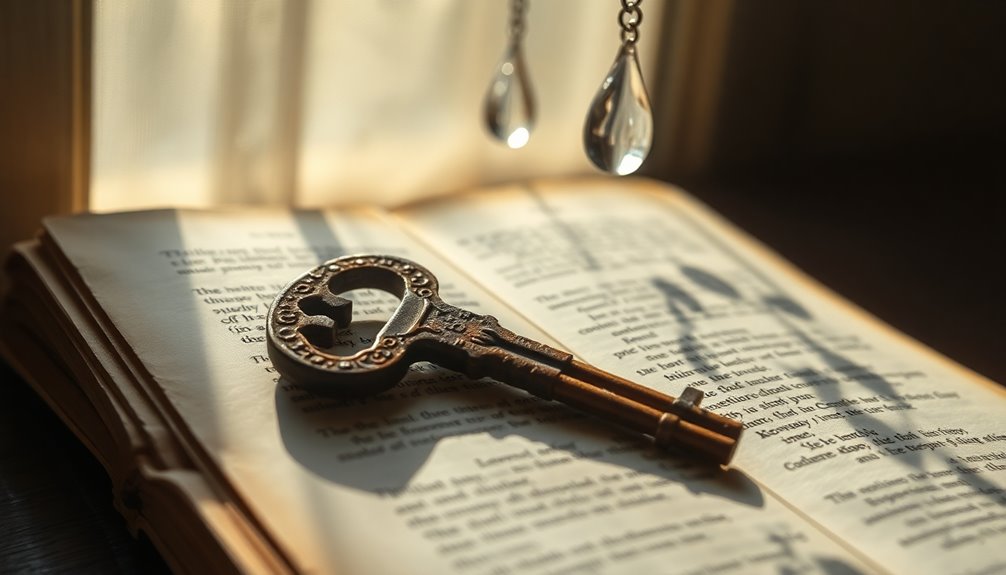
Symbols in poetry evoke powerful emotions that resonate deeply with readers, forging connections to the themes woven throughout the work. Writers use symbols to turn everyday objects into strong feelings, adding depth to their poems. For instance, a red rose often symbolizes love and passion, bringing feelings of romance to the reader.
| Symbol | Emotional Impact |
|---|---|
| Red Rose | Love and Passion |
| Broken Clock | Lost Time or Regret |
| Open Door | New Opportunities |
The emotional impact of symbols can change based on your personal experiences and cultural background. This makes each reader's interpretation unique and special. Poets carefully choose symbols to create a rich emotional landscape, inviting you to explore your feelings.
When you read a poem, think about what the symbols mean to you. Do they remind you of a happy moment or a sad memory? This connection can make the poem feel even more personal and meaningful. So, next time you read, pay attention to the symbols and enjoy the journey through your emotions!
Social Commentary Through Symbolism
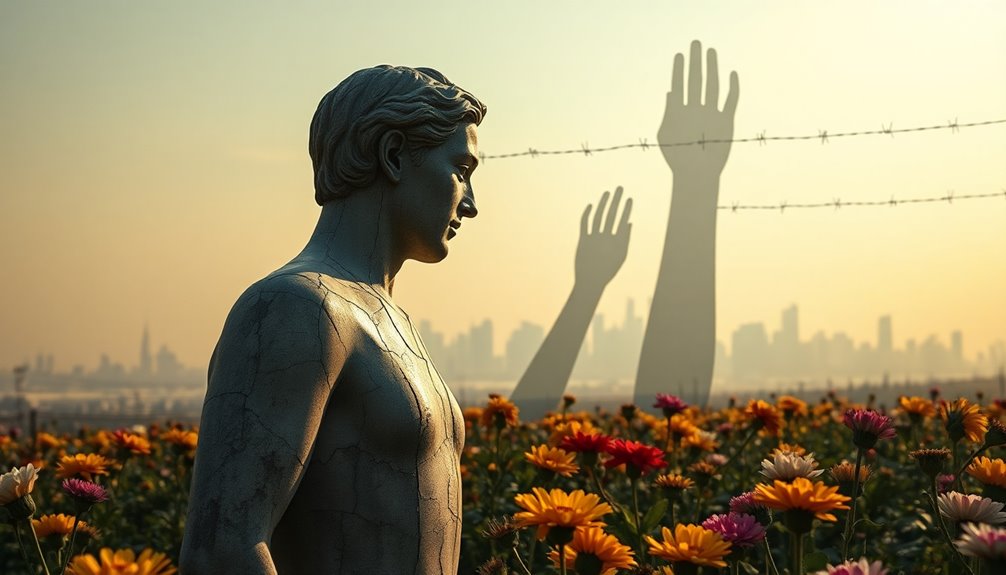
How do poets use symbolism to shed light on social issues? They do this by creating powerful images that speak volumes without saying much at all. For example, poets like William Blake use symbols to critique unfair practices and social injustices.
Here are three ways they do it:
- Highlighting Injustice: Symbols like chimney sweepers reveal the harsh realities of child labor. This makes readers think about the plight of children and the social systems that allow such things to happen.
- Exploring Power Dynamics: Chartered streets and rivers symbolize the control of financial institutions over the lives of ordinary people. This shows how money can dominate lives, helping you understand the struggles many face.
- Encouraging Reflection: The use of symbolism allows poets to subtly comment on themes like inequality and oppression. When you read these poems, you're invited to explore deeper meanings, sparking important conversations about society.
Through these techniques, poets engage readers' emotions and raise awareness of social issues, making their work not just art, but a crucial form of social commentary.
Common Symbols and Their Meanings
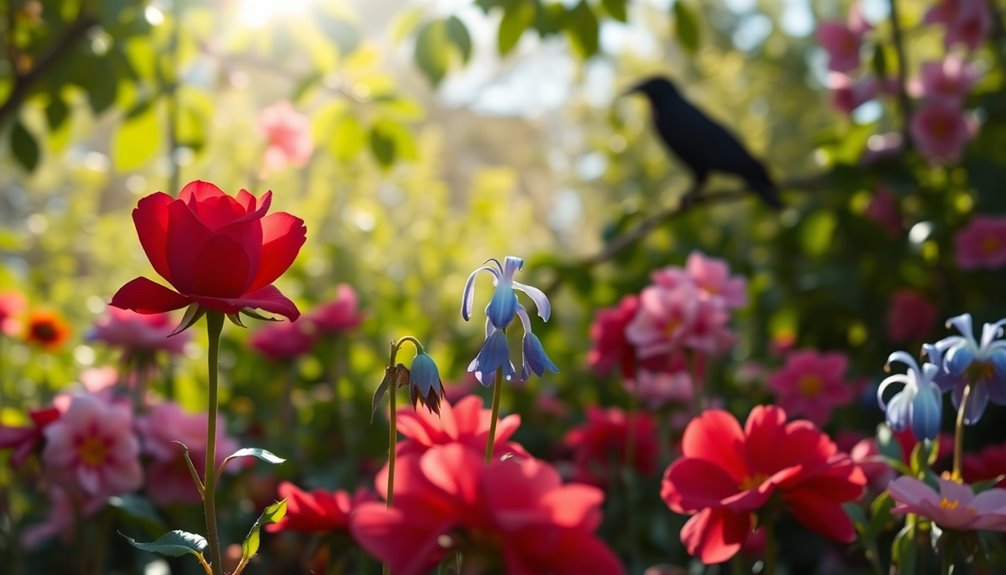
Poets often employ a range of symbols to convey powerful meanings, making their messages resonate with readers. One of the most famous symbols is the red rose. It universally symbolizes love and romance, expressing deep affection and passion. When you see red roses in poetry, you can almost feel the warmth of love blooming.
Another common symbol is the dove, which represents peace and tranquility. When poets use doves, they often want to share feelings of harmony and hope.
Skulls are also interesting symbols; they can remind us of mortality and the inevitability of death, making us think about life's fleeting moments.
Keys symbolize access and freedom. They can open doors to new opportunities, representing the idea of revealing potential.
Similarly, rainbows often shine with hope, promising beauty after storms and tough times.
These symbols, like red roses, help paint vivid pictures in our minds. They bring deeper meanings to poetry, inviting you to explore emotions and experiences.
How to Use Symbolism Effectively
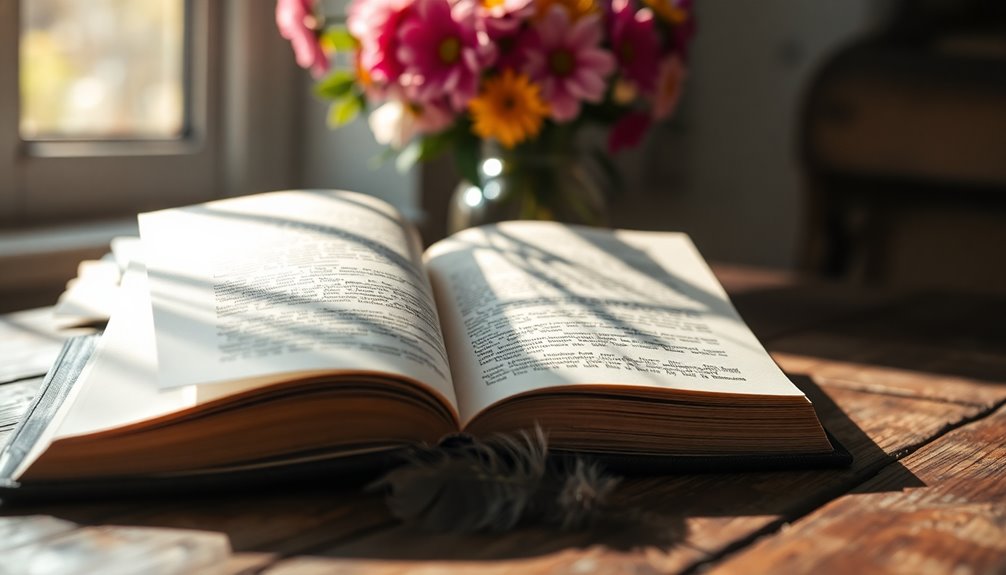
When you're using symbolism in your poetry, it's important to choose symbols that really connect with your poem's themes.
Balancing subtlety and clarity helps your readers understand your message without getting lost.
Plus, considering cultural contexts can make your symbols even more powerful and relatable! Additionally, drawing inspiration from nature in poetry can enhance the emotional resonance of your symbols.
Choose Meaningful Symbols
Choosing meaningful symbols can considerably enhance the emotional resonance of your poetry. When you pick the right symbols, they can help express feelings and ideas in a powerful way.
Here are three tips to guide you:
- Resonate with Emotions: Select images or objects that connect with the emotions you want to share. For example, if you use "black as a symbol," it might represent mystery or sadness, depending on your theme.
- Research Cultural Significance: Understanding the context of your symbols is essential. Some symbols may have different meanings in various cultures, so make sure to explore their significance. This will enrich your poem and help readers connect.
- Encourage Personal Connections: Choose symbols that allow for multiple interpretations. This way, readers can relate the symbols to their own experiences, creating a deeper bond with your work.
Balance Subtlety and Clarity
Balancing subtlety and clarity in symbolism elevates your poetry, allowing readers to engage without feeling lost. When you use symbols, think about how they connect to your poem's main themes.
It's crucial to choose symbols that your audience can easily recognize. This helps create clarity in your writing, making it easier for readers to grasp the deeper meanings without getting confused.
You might want to use familiar symbols or cultural references. These can make your poem more relatable and enjoyable!
Remember, too subtle, and your readers might misunderstand your message; too obvious, and it can feel forced. Finding that sweet spot makes your work richer and more meaningful.
Repetition can also be a great tool! By repeating a symbol throughout your poem, you reinforce its importance while allowing readers to interpret its deeper implications.
This repetition enhances clarity, guiding your audience through the emotions and ideas you want to express.
Consider Cultural Contexts
Cultural context shapes the way symbols resonate within poetry, making it essential to understand their meanings across different backgrounds. When you write or read poetry, you'll discover that symbols can mean different things, depending on where they come from.
For example, the color white might symbolize purity in one culture but mourning in another.
Here are three tips to help you consider cultural contexts effectively:
- Research Symbols: Look into the historical and cultural significance of symbols you want to use. This helps guarantee they fit well in your poem.
- Acknowledge Personal Associations: Remember that symbols might evoke different feelings for each reader. What feels joyful to you might remind someone else of sadness.
- Engage with Diverse Perspectives: Explore various cultural viewpoints. This can enrich your understanding and add depth to the symbolism in your work.
Frequently Asked Questions
What Is Symbolism and Examples?
Symbolism is when you use images, actions, or objects to stand for bigger ideas. For example, a rose can represent love, while a raven might show sadness.
Think about how a rainbow symbolizes hope after a storm! Poets love using nature and colors too. A blue sky can mean calmness, while a red sunset might bring passion.
When you spot symbolism, it adds deeper meaning and makes reading poetry so much more exciting!
What Is an Example of Symbolism in a Poem?
One great example of symbolism in a poem is in William Wordsworth's "I Wandered Lonely as a Cloud."
Here, the daffodils symbolize beauty and joy. When you read about the flowers dancing in the breeze, you can feel the happiness they bring.
They remind you of nature's power to uplift your spirit and bring peace. This connection shows how simple things can have deep meanings and stir your emotions wonderfully!
What Is Symbolism as a Poetic Device?
Symbolism as a poetic device is like a treasure map in a poem!
You'll find images or objects that stand for bigger ideas or feelings. For example, a dove might represent peace.
When you read, you connect with these symbols, discovering layers of meaning. It makes the poem more exciting and helps you feel the emotions the poet wants to share.
What Is the Symbolism Technique in Poetry?
Imagine walking through a garden filled with colorful flowers. Each bloom tells a story, just like symbolism in poetry.
This technique uses images or objects to represent bigger ideas or feelings. For example, a butterfly might symbolize change or transformation.
When you read a poem, look for these symbols! They add depth and help you feel the emotions the poet wants to share.
Symbolism makes poetry exciting and meaningful, inviting you to explore new interpretations!
Conclusion
In summary, symbolism in poetry is like a treasure map, leading you to deeper meanings and exciting discoveries. By recognizing symbols, you uncover hidden emotions and ideas that make poems come alive. As you explore different types of symbols, you'll see how they create connections between words and feelings. So, plunge into the world of symbolism! With every poem you read, you'll find more gems waiting to be uncovered, making your reading experience even more enjoyable and meaningful.

